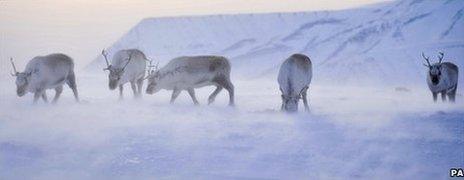Animals 'scared' by bursts of light from power cables
- Published
Lead researcher on the study, Prof Glen Jeffery from University College London, explains why these flashes of light occur
Animals around the world could be scared away from power cables because these give off UV flashes invisible to humans, scientists have said.
Several species' vision was studied by an international team to identify this ultra-violet (UV) sensitivity.
The findings, published in the journal Conservation Biology, claimed habitats and migration could be disrupted.
The flashes, or corona, occur when charge builds up in a cable and is released into the air.
The international team, including scientists from University College London, external and the Arctic University of Norway, external, measured the spectrum of light emitted by these bursts of charge.
They worked out that although the light was invisible to us, it contained wavelengths seen by many other mammals.
"Most mammals will let some [UV light] into their eye," explained UCL vision expert Prof Glen Jeffery, one of the lead researchers in this project.
"We're weird - us and monkeys - because we don't see UV. Most animals do."
'Previously a mystery'
The first animal to reveal its UV sensitivity was the reindeer. And, as the researchers explained, reindeers' avoidance of the power lines running across the Arctic tundra was part of the inspiration for this project.
Dr Nicholas Tyler, the other lead author, said it had been assumed that rather than avoiding the power cables themselves, animals steered clear of passages cut in forested areas before pylons were installed.
"Forest animals will not cross clear-cuts," he said.
"But for us in the Arctic, avoidance of power lines is difficult to explain - there are no trees, yet the reindeer still avoid the power lines."
The animals keep as much as 5km (3 miles) from either side of the cables.
"This has been a mystery," Dr Tyler added. "We have now come up with a mechanism [to explain it]."

Reindeer vision was an inspiration to investigate this mystery
This research required a detailed understanding of animal vision, which was where Prof Jeffery came in.
Having discovered in 2011 that reindeer eyes were sensitive to UV light, Prof Jeffery went on to study the eyes of almost 40 mammal species, revealing all were UV-sensitive, external.
Since, as the researchers added, coronas "happen on all power lines everywhere", the avoidance of the flashes could be having a global impact on wildlife.
"It has always been assumed that power lines - masts and the cables strung between them - were passive structures standing immobile in the terrain, and therefore inoffensive for animals," said Dr Tyler.
"As a result of this work, we now consider them as chains of flashing light stretching across the tundra in the winter darkness, and that's why the animals find them so offensive."
The random and unpredictable nature of these flashes were particularly problematic, he added, as the animals could not easily adapt to them.
Prof Jeffery said he hoped power companies would now consider ways to address the issue.
- Published11 March 2014
- Published26 May 2011